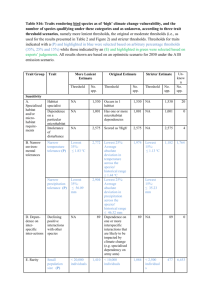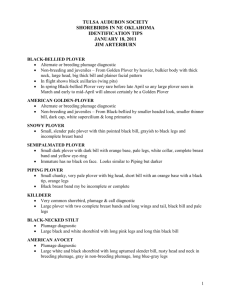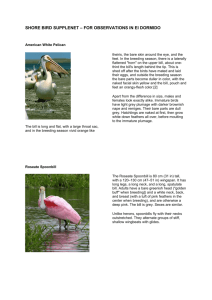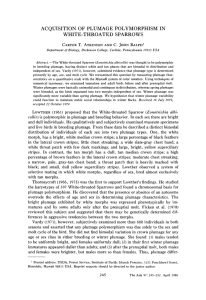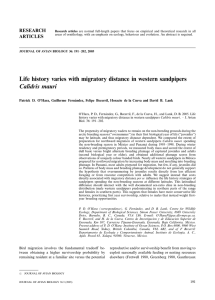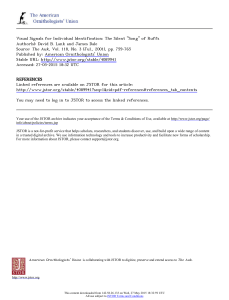Orders Anseriformes, Galliformes, Gaviiformes, Podicipediformes
advertisement
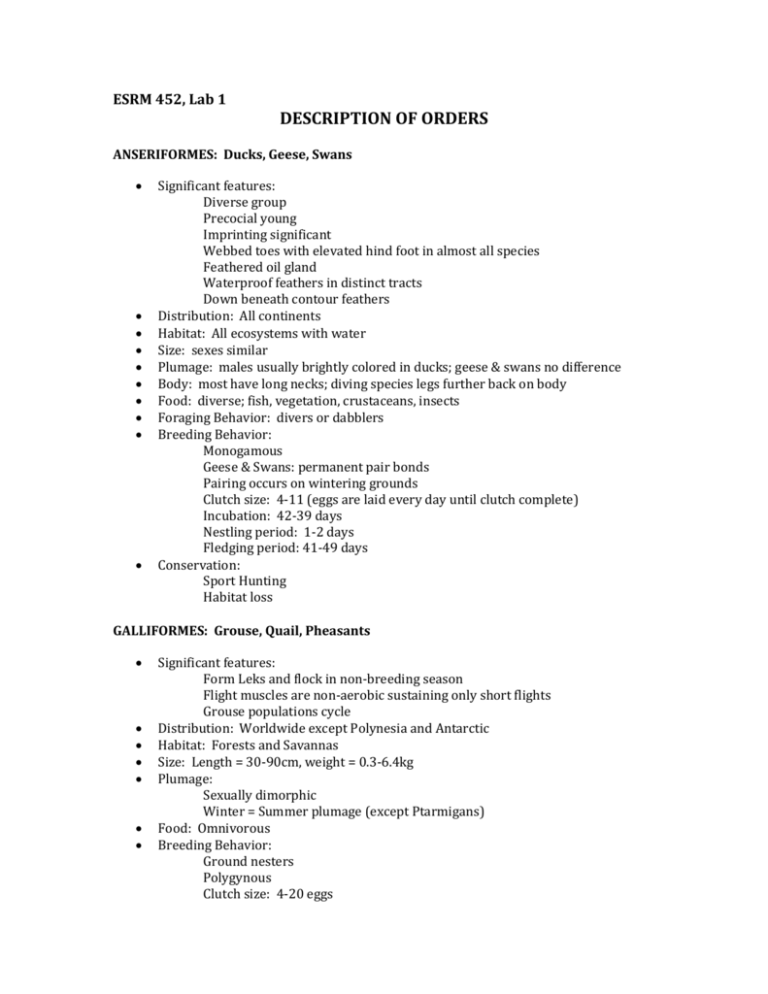
ESRM 452, Lab 1 DESCRIPTION OF ORDERS ANSERIFORMES: Ducks, Geese, Swans Significant features: Diverse group Precocial young Imprinting significant Webbed toes with elevated hind foot in almost all species Feathered oil gland Waterproof feathers in distinct tracts Down beneath contour feathers Distribution: All continents Habitat: All ecosystems with water Size: sexes similar Plumage: males usually brightly colored in ducks; geese & swans no difference Body: most have long necks; diving species legs further back on body Food: diverse; fish, vegetation, crustaceans, insects Foraging Behavior: divers or dabblers Breeding Behavior: Monogamous Geese & Swans: permanent pair bonds Pairing occurs on wintering grounds Clutch size: 4-11 (eggs are laid every day until clutch complete) Incubation: 42-39 days Nestling period: 1-2 days Fledging period: 41-49 days Conservation: Sport Hunting Habitat loss GALLIFORMES: Grouse, Quail, Pheasants Significant features: Form Leks and flock in non-breeding season Flight muscles are non-aerobic sustaining only short flights Grouse populations cycle Distribution: Worldwide except Polynesia and Antarctic Habitat: Forests and Savannas Size: Length = 30-90cm, weight = 0.3-6.4kg Plumage: Sexually dimorphic Winter = Summer plumage (except Ptarmigans) Food: Omnivorous Breeding Behavior: Ground nesters Polygynous Clutch size: 4-20 eggs Incubation: 21-27 days Conservation: Hunting Habitat changes GAVIIFORMES: Loons Significant features: Adapted for underwater pursuit Rocks in gizzard Habitat: Breeds at high-latitude lakes Winters mainly on saltwater Size: Male > females Food: Mainly fish but also crayfish, shrimp and leeches Breeding Behavior: Nest substrate: Built nests near or on water Solitary (Red-throated loon colonial?) Clutch size: 1-3 eggs, median = 2 Incubation: 24-30days Precocial young Plumage: All have vertical strips and white strips White belly Foraging behavior: Short dives but can swim great distances Diving depth: Max = 80m Conservation: Habitat degradation Acid rain Disturbance at nest Trophication of lakes PODICIPEDIFORMES: Grebes Significant features: Swallow feathers (to entangle fish bones, feathers are also feed to young) Regurgitate pellets consisting of bones Feet are at the extreme hind end of body and can pivot in all directions (act as rudders and paddles) Elaborate courtship behavior Non-flying species in South America Distribution: Aquatic habitats on all continents and many islands (incl. New Zealand and Madagascar) Habitat: Lakes (breeding season), fresh and saltwater during non-breeding season Size: Length = 23-76cm, weight = 0.15 – 1.5kg Body and Bill: Elongated in piscivorous species Rotund in insectivorous species Plumage: Summer and winter plumage Food: Fish, aquatic insects Foraging behavior: Pursuit diving Breeding Behavior: Monogamous Colonial and solitary breeding species Aquatic nests (concealed in vegetation) Clutch size: 2-6 eggs Incubation: 27-28 days by both sexes, starting with the first or second egg Independence: 44-79 days Cover nest with vegetation when disturbed during incubation (Chickadees do this too) Young are precocial and ride on adult’s back Conservation: Oil spills Habitat destruction PROCELLARIIFORMES: Albatrosses, Storm Petrels, Shearwaters, Diving Petrels Significant features: Tubenoses Plentigrade Oily fluid Flight patterns Wing molt Habitat: Pelagic during non-breeding season Breed on islands Size: Petrels: Length = 12-25cm, Wingspan = 32-56 Albatrosses: Length = 70-140cm, Wingspan = 170-250cm Food: Mainly Squid, fish, crustaceans, plankton Breeding Behavior: Nest substrate: Burrows, cliff edges, but also built nests Colonial to solitary breeder Sexual maturity: 4-5yrs Mate for life Clutch size: 1-3 eggs, median = 1 egg Incubation: 65-79d in larger species Fledging: 120-280 days Feeding of young Conservation: Fisheries Release of predators on islands Power lines





